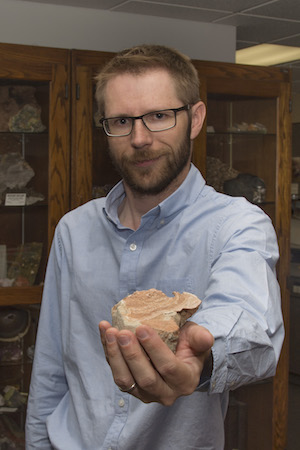The world’s oldest farmers: ISU’s Leif Tapanila participates in international study documenting oldest evidence of agriculture by insects
June 23, 2016
SMITHFIELD, Australia – An international team of researchers, including Idaho State University’s Leif Tapanila, has discovered the oldest fossil evidence of agriculture, not by humans, but by insects.

The team, led by Associate Professor Eric Roberts from James Cook University in Australia, discovered the oldest known example of fungus gardens within fossil termite nests from the Great Rift Valley of Africa in 25-million-year-old sediments.
Researchers from Wageningen University in the Netherlands and Ohio University also participated in the project.
Fungus farming termite colonies cultivate fungi in gardens in subterranean nests or chambers, helping to convert plant material into a more easily digestible food source for the termites.
“Termites are expert builders, and their tunnels and mounds leave a great fossil record,” said Tapanila, Director of the Idaho Museum of Natural History and ISU associate professor of geology, who is an expert in ancient traces left by animals. “In this study we find nest construction identical to modern fungus-farming termites, an unprecedented behavior 30 million years ago."
Roberts said that scientists had previously used DNA from modern termites to estimate the origin of termite ‘fungus farming’ behavior back to at least 25 to 30 million years ago.
This has now been confirmed using the new trace fossil evidence from Tanzania, allowing researchers to more accurately characterize the timing and evolution of this behavior, something thought to have significantly modified the environment and landscape.
Patrick O’Connor, professor of anatomy at Ohio University, added, “This type of study emphasizes the need for integrating perspectives from the fossil record with modern approaches in comparative biology—it is a holistic approach to evolutionary biology and significantly informs our understanding of environmental change in deep time.”
Study co-author Associate Professor Duur Aanen from Wageningen University said that the transition to agriculture dramatically increased the range of possible habitats for both the fungus-growing termites and their domesticated fungi, very much like humans and their domesticated crops and livestock, tens of millions of years later.
While the cradle of termite agriculture presumably was in an African rainforest, the transition to fungiculture helped the termites to disperse to less favorable dry savannas and also out-of-Africa migrations into Asia.
"This discovery pushes back the beginning of the termite-fungus symbiotic relationship to at least 31 million years ago,” says Paul Filmer, program director in the National Science Foundation’s Directorate for Geosciences, which funded the research. “Since some 90 percent of the wood in the dry environment studied is digested by termites, understanding the development of this symbiotic relationship is important to our knowledge of the history of carbon cycling in these forests."
“The phenomenon might have been triggered by the initial development of the Great Rift Valley in this part of eastern Africa, and the dramatic transformation of the landscape around this time,” Roberts added.
The research is part of an ongoing study focused on the evolution of a poorly known portion of the Great Rift Valley known as the Rukwa Rift, which has produced an array of unexpected geologic and palaeontologic discoveries in the past few years.
The results of the study “Oligocene termite nests with in situ fungus gardens from the Rukwa Rift Basin, Tanzania, support a Paleogene African origin for insect agriculture” was published June 22 in the journal PLOS One.
The study’s authors include Roberts, Christopher N. Todd, Duur K. Aanen, Tânia Nobre, Hannah L. Hilbert-Wolf, Patrick M. O’Connor, Tapanila, Cassy Mtelela, and Nancy J. Stevens.
The study was funded by the US National Science Foundation, the National Geographic Society (CRE), James Cook University, Ohio University, Portugese Foundation for Science and Fellowship and a Marie Currie Fellowship.
Cutline information:
ISU's Leif Tapanila holding the ancient termite mound from Tanzania that shows evidence for fungal farming.
Please note: The bulk of this press release was written by Alistair Bone, from James Cook University, Australia. Our office updated it with information on ISU to localize the story.
Categories:
